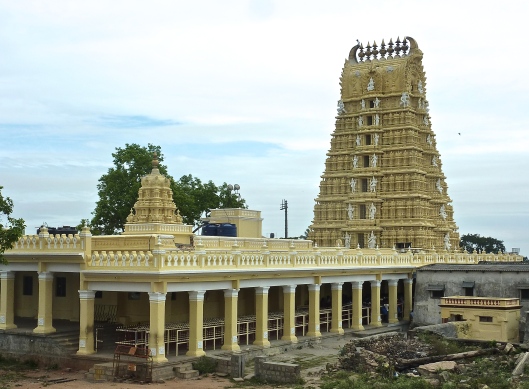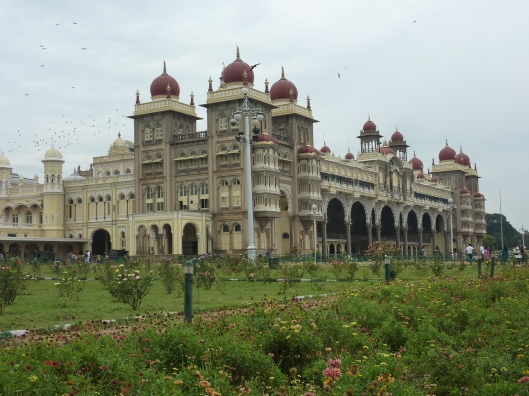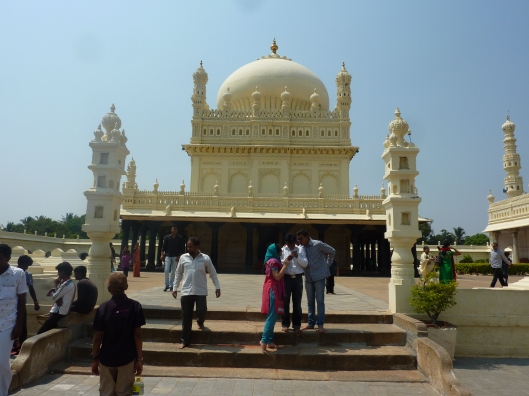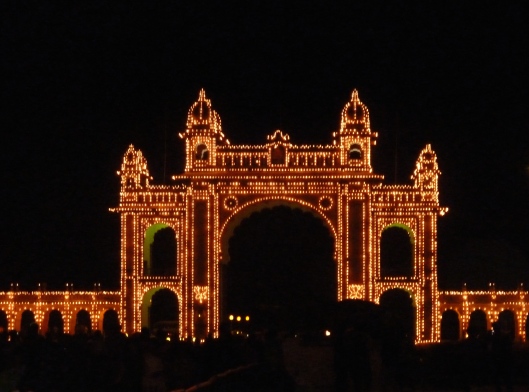Mysore
Mysore is the city of silk and sandalwood and we enjoyed it enormously. Our heritage hotel was originally built to house the European guests of the Maharajah. Now refurbished, we enjoyed the simple colonial-style décor and the impeccable service – not to mention the bar and the meals in the courtyard.
After a delicious buffet lunch on arrival we went off in search of silk and some tailors; something approaching a retail rampage followed in the Government Silk Store and we exhausted the stitching schedule of the tailor there and several of us took off in a tuk tuk for help from another. The church opposite was crowded with wedding guests and we found ourselves photographing the happy couple posing for photographs – and their getaway car.

Wedding car with fresh flower decorations
The following day we drove up Chamundi Hill to join the throngs visiting the Chamundeswari Temple – home of the patron goddess of Mysore.

The Temple at Chaumundi Hill
Our wrists were bound with braided red cord, our foreheads marked with the red ‘blessing spot’, and Kim performed puja on our behalf while we explored a small temple on the perimeter.

Blessing braids at the Temple

Merchandise at Mysore
There were more crowds at Mysore Palace – home of the Maharaja – but Dileesh programmed our tour seamlessly and with headphones we each entered the private world of the palace and were able to forget the throngs around us.

Mysore Palace
It was rebuilt at the beginning of the 19thC after the original palace burned down and there is a curious twist to the transfer of Victoriana into the Indian idiom. Lots of pink and turquoise and lashings of gold. The province of Mysore had rich supplies of gold in its mines and the British were quick to forge alliances here and trade in the gold. Currently there is a dilemma for succession. The last Maharajah died a year ago without an heir and the Maharani is rumoured to be planning to adopt a nephew to allow the succession to continue. Preparations were in place to mark the anniversary of the death the following day.
Lunch was described in advance as a ‘bit of a risk’ but the experience of fast food service in Mysore left us wanting more. Dish after dish appeared on the table and only the shopping in the downstairs forecourt slowed the pace of departure for the Tipu Sultan Palace.
Tipu Sultan is an 18thC hero whose father had restored power to this state as the Mughals declined and in the Mysore wars defeated the British. He was a well educated man speaking Arabic, Kannada, Persian and Urdu who ruled with integrity and wisdom. He died in the 4th Mysore War in 1799 and this led to the decline of Srirangapatna and the transfer of power to Mysore.
This summer palace is maintained as a memorial museum and is a delightful example of gracious living. It was built in 1784 in the Indo Islamic style and is constructed mostly of teak. It stands on a raised platform and open corridors run around all four sides supported by wooden pillars. Four discreet staircases access the upper storey, and upper balconies overlook the central inner courtyard, an audience hall.

Tipu Sultan Summer Palace
Most strikingly every inch of wall space is painted colourfully and artistically, with battles scenes and portraits surrounded by beautiful garlands and geometric patterns.
Our visit to Mysore coincided with the Sunday illuminations of the palace and we returned just after dusk to view the spectacle and hear the collective gasp when the lights were turned on. Nothing quite like this anywhere else
Our return to the hotel was followed by some merry moments in the delightful bar before another excellent meal under the stars in the courtyard. All helped by knowing we did not have a long journey in the morning.

